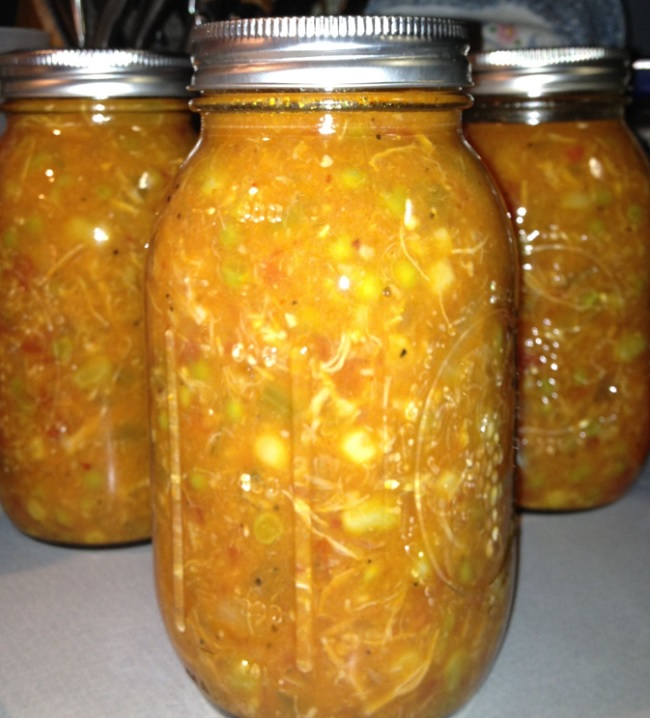
Besides meat and sauce options, a good Carolina barbecue restaurant has a few common elements. Pigs of all shapes, sizes and personalities fill the décor. Paper towels are on the table. And Brunswick stew is on the menu.
Granted, the barbecue of stews appears most often in the Eastern part of the state. We discussed this in the 3 Beers Down episode of The Low & Slow Barbecue Show. Unlike corn sticks, another Eastern NC favorite, Brunswick stew has crept westward. It is now a common menu item for the best Carolina barbecue restaurants.
What is Brunswick stew? Where does Brunswick stew originate? And how do you make Brunswick stew? Keep reading for all the details. I also share Randy Abernethy’s recipe for Brunswick stew mentioned during Tailgating Time on the Low & Slow Barbecue Show.
What is Brunswick Stew?
Recipes for Brunswick stew vary from place to place. Generally, Brunswick stew is a tomato-based stew that includes vegetables and meat, often small game meat like squirrel or rabbit. Humorist Roy Blount Jr. isn’t far from the mark with “Brunswick stew is what happens when small mammals carrying ears of corn fall into barbecue pits.”
America is infested with tree rats but not many people hunt them. Plus, it is hard to rely on a corn-laden squirrel falling out of a tree into your Weber Smokey Mountain. That said barbecue chicken is an easy substitute in Brunswick stew.
Naturally, in North Carolina, we like to add smoked pork to the mixture. When your chicken and pork are shredded and added to the pot, it creates a hearty consistency every good stew needs on a cold Carolina day. It’s hard to beat a good thick paste-like bowl of stew in the winter or early spring.
The recipe below includes meat and potatoes in the mix, making North Carolina’s version of Brunswick stew thicker than varieties you’ll find in Virginia or Georgia. Virginia’s stew usually includes chicken. Meanwhile, the Georgia version leans toward a more intense spice. Recipes in North Carolina and Georgia usually feature smoked pork. Good barbecue restaurants in both states feature Brunswick stew as a menu staple.
Where does Brunswick stew originate?
The origin of Brunswick stew is hotly debated.
Georgia, Virginia, and North Carolina all claim to be the birthplace. However, both North Carolina and Virginia have counties called Brunswick. In Glynn County, Georgia, the city of Brunswick is on the state’s southeastern coast near Jekyll Island and three other barrier islands, including St. Simons Island.
Both Brunswick County, Virginia, and Brunswick, Georgia, were named in honor of the German Duchy of Brunswick-Luneburg, home to the House of Hanover that once ruled the British throne. Likewise, when North Carolina’s Brunswick County was created from New Hanover and Bladen counties in 1764, it was named after Britain’s King George I, Duke of Brunswick.
While it is reasonable to assume that any stew made in a place called “Brunswick” would carry the same name, Georgia’s claim might be the strongest. It’s hard to argue with a 25-gallon iron cauldron outside the town. There, it sits atop a concrete plaque that declares “In this pot, the first Brunswick Stew was made on St. Simon Isle July 2, 1898.”
Debate a concrete plaque and iron cauldron? No thanks. People in Virginia do. The conflict led to “Stew Wars.” The commonwealth of Virginia landed a legislative victory and a resolution in the mid-1980s. It named Brunswick County, Va., the original home of Brunswick stew. Georgia countered with a resolution, and the start of an annual “Brunswick Stewbilee.”
North Carolina hasn’t waded too far into the fray. Let our neighbors bicker. We’ve got bigger hogs to cook. Instead, I think my fellow Carolinians are more proud of perfecting the recipe. We add pork cooked low and slow, potatoes, and our own choice of spices.
What is Brunswick stew made of?
Sauce Recipe
Makes about 3 ½ cups which you will set aside and save for later.
In a 2 quart saucepan melt ¼ cup of butter over low heat then add:
- 1 ¾ cup ketchup
- ¼ cup yellow mustard
- ¼ cup white vinegar
Blend the ingredients until smooth, then add:
- ½ tablespoon chopped garlic
- 1 teaspoon coarse ground black pepper
- ½ teaspoon crushed red pepper
- 1 tablespoon Liquid Smoke
- 2 tablespoons Worcester sauce
- 1 tablespoon Tabasco sauce
- ½ tablespoon fresh lemon juice
Blend until smooth, then add:
- ¼ cup dark brown sugar
Keep stirring and increase the heat to simmer – but not boil – for about 10 minutes.
Stew Recipe
In a large, 2-gallon pot, melt ¼ pound of butter, then add:
- 3 cups of small diced potatoes.
- 1 cup of small diced onion
- 2 14 ½ ounce containers of chicken broth.
- 1 pound of baked chicken (white and dark)
- 8-10 ounces of smoked pork
Bring ingredients to a rolling boil, stirring until potatoes are nearly done, then add:
- 1 8 ½ ounce can of early peas
- 2 14 ½ ounce can of stewed tomatoes – chop the tomatoes and add the liquid and tomatoes.
- Sauce you prepared above
- 1 16 ounce can of baby lima beans.
- ¼ cup of Liquid Smoke
- 1 14 ounce can of creamed corn
Slow simmer for 2 hours.
Yields 1 gallon.
FAQ: Additional Questions about Brunswick Stew
What are the main ingredients of Brunswick stew?
The main ingredients of Brunswick stew typically include tomatoes, vegetables such as potatoes, onions, peas, lima beans, and corn, along with meats like chicken and smoked pork. Variations may exist in different regions, with some recipes incorporating additional spices or ingredients unique to local tastes and traditions.
What is the difference between beef stew and Brunswick stew?
Brunswick stew typically contains a variety of meats such as chicken, pork, or small game like squirrel or rabbit, whereas beef stew primarily consists of beef as the main protein. Additionally, Brunswick stew often includes tomatoes, whereas beef stew might not. The flavor profiles and regional variations also distinguish the two stews.
Can Brunswick stew be prepared without meat?
Brunswick stew can be adapted for vegetarian or vegan diets by omitting the meat and using plant-based protein sources like tofu or tempeh. Alternatively, some recipes may feature hearty vegetables such as mushrooms or lentils as substitutes for the meat, maintaining the stew’s rich flavor and texture.
Is Brunswick stew the same as burgoo?
While both Brunswick stew and burgoo are hearty stews, they are not the same. Burgoo typically contains a wider variety of meats, including beef, mutton, and sometimes game meats, along with vegetables and thickening agents like cornmeal. Brunswick stew, on the other hand, is more commonly associated with chicken, pork, or small game meats, along with tomatoes and other vegetables.
How does the addition of smoked pork enhance the flavor and texture?
The addition of smoked pork contributes to its distinctive smoky flavor and adds richness to the dish. For those who do not consume pork, alternatives like smoked turkey or smoked beef can be used to achieve a similar depth of flavor. Additionally, some recipes may rely solely on chicken or incorporate vegetarian substitutes to cater to different dietary preferences.
Is Brunswick stew traditionally served as a standalone dish?
Brunswick stew is often served as a standalone dish, accompanied by cornbread, hush puppies, or biscuits to complement its hearty flavors. Coleslaw or a side salad may also be served alongside the stew to provide a refreshing contrast. Some diners enjoy pairing Brunswick stew with traditional barbecue dishes or Southern sides like collard greens or macaroni and cheese.
Are there any recommended cooking techniques?
To achieve the desired consistency and flavor profile, it’s important to simmer the ingredients slowly over low heat for a prolonged period, allowing the flavors to meld together. Stirring occasionally prevents sticking and ensures even cooking. Adjusting the seasoning to taste throughout the cooking process helps to balance the flavors and enhance the overall richness of the stew.
How do you thicken Brunswick stew?
Brunswick stew can be thickened by various methods. One common method is to mash some of the potatoes or vegetables in the stew to release their starch and thicken the broth. Alternatively, you can create a slurry by mixing equal parts cornstarch or flour with cold water and then adding it to the simmering stew until desired thickness is achieved.
Is it better to thicken stew with flour or cornstarch?
Both flour and cornstarch can be used to thicken stew, but they have slightly different properties. Flour tends to create a more opaque and hearty texture, while cornstarch produces a smoother, clearer consistency. Choose the thickening agent based on your desired texture and dietary preferences.
Can you use mashed potatoes to thicken stew?
Yes, mashed potatoes can be used to thicken stew. Simply add mashed potatoes to the simmering stew and stir until the desired thickness is achieved. This method adds flavor and texture to the stew while naturally thickening it.
Why does my Brunswick stew taste like sugar?
If your Brunswick stew tastes overly sweet, it could be due to the caramelization of sugars in the ingredients during cooking. To balance the sweetness, try adding more savory elements like salt, spices, or acidic ingredients like vinegar or lemon juice.
What causes bitterness in Brunswick stew?
Bitterness in Brunswick stew can be caused by overcooking certain ingredients, such as burnt onions or garlic, or by using ingredients that are past their prime. It’s essential to monitor the cooking process carefully and ensure that ingredients are fresh and properly cooked to avoid bitterness. Adjusting the seasoning and adding a touch of sweetness can also help balance out bitterness.
Is it OK to leave Brunswick stew out overnight?
No, it is not safe to leave Brunswick stew out at room temperature overnight. Bacteria can grow rapidly at temperatures between 40°F (4°C) and 140°F (60°C), leading to foodborne illness. It’s important to refrigerate any leftovers promptly within two hours of cooking.
How many days is Brunswick stew good for?
When properly stored in an airtight container in the refrigerator, Brunswick stew can typically be kept for 3-4 days. It’s important to ensure the stew is cooled down completely before refrigerating and to reheat it thoroughly before consuming.
About the Author

Smoked meat, barbecue enthusiast, news journalist, and sports radio broadcaster Michael “Chigger” Willard collects a storybook of life captured through the lens of people he encounters. With a perspective seasoned by small town life in the Deep South, he dedicates conversations to uncovering savory nuggets of information, light-hearted moments of humor, and revealing glimpses of humanity.
Want more?
- Podcast Episodes
- Barbecue Blogs
- BBQ News & Recipes
Subscribe to The Lowdown BBQ Newsletter!


